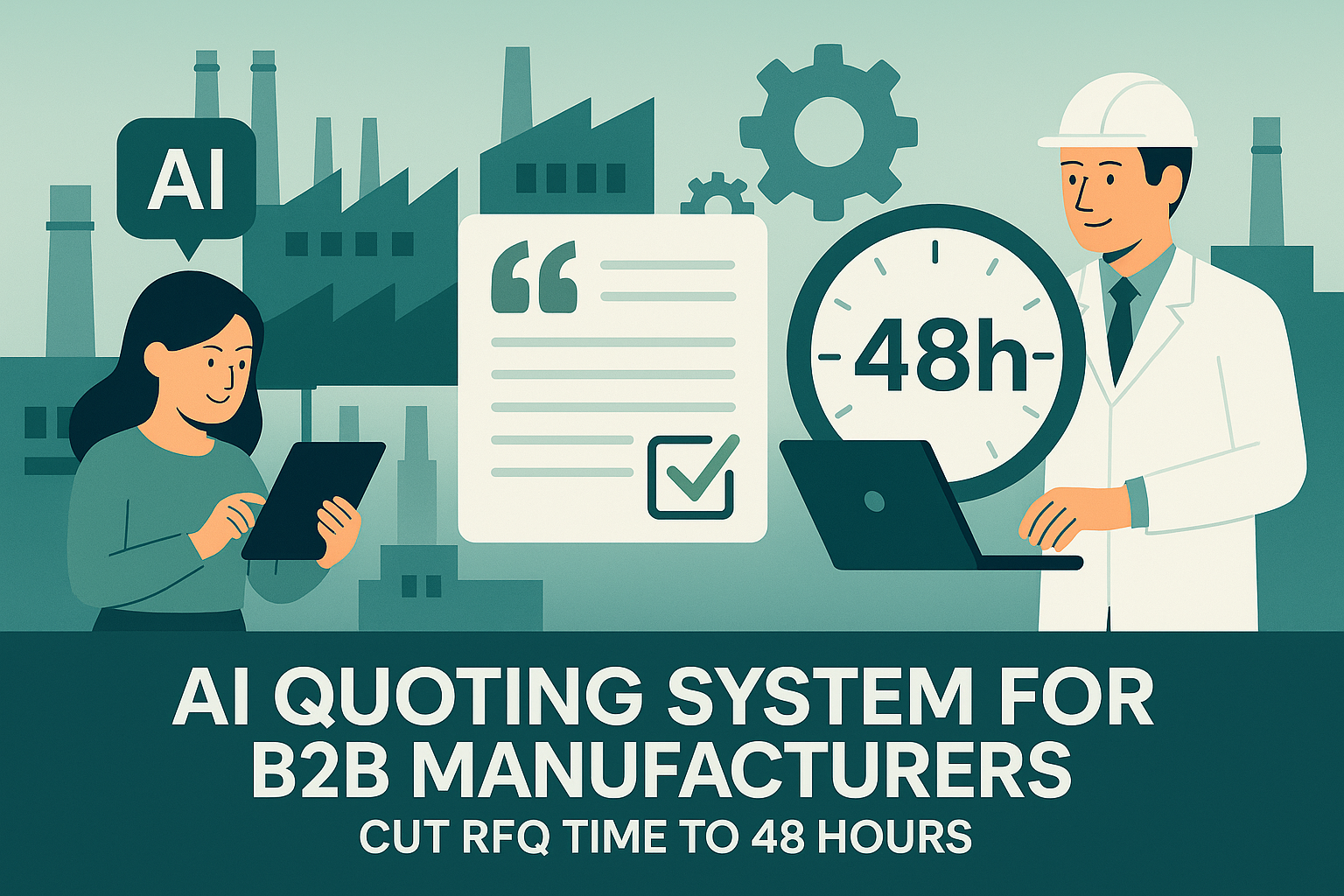Procurement teams don’t wait anymore. If your quote takes a week, arrives full of unclear details, or fails to match internal delivery terms and pricing logic, you don’t just lose the bid—you lose trust. That delay costs more than time. It costs revenue. And ultimately, it signals that your operations aren’t built for scale.
This guide breaks down how B2B manufacturers are now using artificial intelligence to streamline the quoting system itself—cutting RFQ time from 8 days to 48 hours, producing procurement-ready estimates that reflect real-time data, validated materials, and customer preferences with zero ambiguity. Because quoting isn’t just about cost—it’s about positioning your company to win.
Let’s walk through how it works, why it matters, and how leading industrial teams are using this exact system to create instant quotes that secure Fortune‑500 contracts.
The Quiet Killer of Enterprise Deals
He didn’t lose the deal because of price. Or product. Or compliance issues.
He lost it because the quote took too long to get out the door. And by the time it landed, the buyer had already shortlisted two competitors—one of whom returned a fully validated, procurement-ready quote within 48 hours. Clean formatting. Zero ambiguity. Ready for internal approval.
No follow-ups. No rework. No guessing. Just a quote that said: “You can trust us.”
That COO won the PO.
If you’ve been in B2B long enough, you’ve seen it happen. Maybe it’s happening to you right now. You’re dancing—final calls with sales, engineering is checking the spec sheet, pricing is waiting on freight, and procurement’s already gone quiet. It’s the same broken rhythm every time—especially on complex projects, where the quoting process involves layers of specs, dependencies, and teams that don’t move at the same pace. That silence you hear? That’s your quote dying in the inbox of someone who doesn’t have time to explain why you’re too slow.
And if you’re running operations, if you’re responsible for quote velocity, accuracy, and conversion, then I need you to hear this without flinching:
Quoting is not paperwork. It’s positioning.
It is not an administrative step before the sale. It is the moment where your customer decides if you’re built for scale or just reacting. If your internal systems are smooth or stitched together with manual patches. If you’re the partner who’ll deliver on time, or the one who asks for an extension two weeks into production.
Fortune-500 buyers don’t care how great your product is if your quote takes six days and three emails to finalize. They don’t forward that quote. They don’t explain why you’re out. They just award it to someone else—someone who built a quoting engine that speaks the language of velocity.
At Optimum7, we’ve spent the past 18 months architecting and deploying real-time quoting engines that take RFQs from spec sheet to signed PO in under 48 hours. This article isn’t fluff. It’s a field manual for COOs, quoting directors, and operations leads who know damn well they’re leaking millions out of their pipeline because the quoting process is too slow, too fragile, too human-dependent.
This quoting transformation is just one piece of a larger evolution. Across the B2B landscape, automation is quietly—but radically—rewriting how companies engage, convert, and scale. Here’s how AI is driving that transformation across the entire client lifecycle
We’re going to walk through:
- The architecture behind a real-time quote system that validates specs, configures custom builds, and generates pricing dynamically.
- The AI-powered prompt library that cuts engineering time in half while increasing quoting accuracy.
- The ROI modeling proves why investing in this system creates more margin than any new lead-gen strategy ever could.
- And how to schedule a live walkthrough of a working 48-hour RFQ engine, built and battle-tested inside real mid-market and enterprise operations.
This isn’t a theoretical guide. This is what your competitors are already doing.
And if quoting is still something your team builds in Excel—if reps still say “I’ll get that to you early next week”—then you’re already behind.
But here’s the good news:
This is fixable. In weeks, not quarters.
This doesn’t require a full ERP overhaul.
And once you install the engine, the difference is immediate. Not just in the speed of quotes, but in the quality of the deals you win.
Because once a buyer sees you can quote like this, they stop looking at anyone else.
The War Inside the Quote Cycle — Where Speed Dies
Everyone’s obsessed with filling the funnel.
But the real leak? It’s the dead space between “Send specs” and “Here’s our offer.” That’s where momentum stalls—not from disinterest, but from silence. The kind that slowly kills deals before anyone even says no.
If you’re a COO, you’ve lived this.
The sales team receives the RFQ. It’s detailed. Complex. High-value. A Fortune-1000 prospect, maybe a national distributor—exactly the kind of account that changes your quarter.
Sales hands it off to engineering.
Engineering says, “We’ll review and get back to you.”
Then:
- Material questions.
- A tolerance issue.
- Purchasing checks leads to time.
- Pricing waits on updated freight logic.
- Sales nudges for updates.
- The buyer goes quiet.
And just like that, trust bleeds. The quote hasn’t even left the building.
It’s not a talent problem. It’s a fragmentation problem. The knowledge required to generate a confident quote is scattered across five teams, three spreadsheets, and two Slack threads.
Here’s how the delay usually stacks up:
| Department | Role in Quoting | Typical Delay |
| Sales | Gathers initial RFQ + buyer needs | 0–1 days |
| Engineering | Validates specs, tolerances, build | 2–3 days |
| Purchasing | Confirms material availability | 1–2 days |
| Pricing/Finance | Applies margins, shipping, variables | 1–2 days |
| Admin | Formats quote, checks compliance | 1 day |
Best-case quote time? 5–9 business days.
Now, imagine the buyer. They’ve sent six RFQs and need a decision by Friday. You reply the following Tuesday.
They don’t open it.
Because quoting isn’t just operational—it’s psychological.
A fast quote signals competence. Preparedness. Control.
A slow quote triggers procurement anxiety. It whispers: “If this is how they quote, how will they handle a change order?”
And the fallout isn’t just external.
Sales gets frustrated.
Engineering feels squeezed.
Ops becomes the bottleneck referee.
The fix isn’t more hustle. It’s a better system.
Speed in quoting isn’t a luxury—it’s a leadership issue. A cultural indicator. And when you install a quoting engine that compresses this chaos into two days or less, something shifts.
Not just in time saved, but in the quality of deals you win.
What Fortune‑500 Buyers Expect Now — The New Language of Procurement
The buyer never said you were out of the running. They just stopped replying.
You sent the quote. You followed up. You waited. You thought maybe they went another direction. You were right. But not because of price. And not because of product.
You lost because your quote didn’t speak the language procurement speaks now.
Procurement isn’t what it used to be. The days of long lunches and manual reviews are over. Today’s procurement managers are digital-first, overleveraged, and making decisions inside enterprise tech stacks you don’t even see.
By the time your quote hits their inbox, they’ve already scanned it through a portal. Parsed it through auto-formatting. Checked for compliance indicators. Scored it against other vendors. And if your quote doesn’t make that process easy?
They ghost you.
Because if your quote doesn’t reflect known customer preferences—like preferred delivery terms, format standards, or compliance language—it creates friction instead of confidence.
Let’s break down exactly what Fortune‑500 buyers expect in 2025:
1. Quotes That Align with Internal Approval Systems
Procurement teams have quote templates. Internal formatting logic. Approval paths with embedded metadata.
If your quote shows up in an email with inconsistent formatting, vague line items, no delivery commitment, and no spec validation, it doesn’t get routed. It gets flagged. And then forgotten.
The buyers won’t tell you this. Why would they? You’re just one of ten vendors. If your quote requires work on their end, you’re gone.
A 48-hour quote isn’t just fast—it’s formatted to fit approval paths. That’s why it gets routed, not ignored. That means:
- Breakdown by SKU, spec, and variant
- Cost center mapping
- Tiered pricing logic for different MOQs
- Built-in compliance clauses
- Pre-cleared delivery terms
2. Digital Procurement Integration
If your prospect is a Fortune‑500 manufacturer, distributor, or platform operator, chances are they use:
- SAP Ariba
- Coupa
- Jaggaer
- Oracle Procurement Cloud
- Custom portals built into Salesforce or NetSuite
And they expect quotes they can upload directly—no cute PDFs, no broken logic, no formatting drama.
The 48-hour quoting engine we deploy at Optimum7 generates both human-facing and procurement-facing versions of every quote. One tells the story. The other gets the PO approved.
Decision Acceleration Metrics
Here’s what most quoting teams miss:
Buyers don’t just want a quote.
They want to be able to justify that quote to someone else. Their manager. Their CFO. Their risk team.
That means you’re not quoting for the buyer. You’re quoting for their internal meeting.
Which means your quote should do the following:
- Validate the spec sheet against engineering logic
- Include alternate recommendations (e.g., “If timeline is critical, use X instead of Y”)
- Call out lead time dependencies
- Embed support for freight, duties, and packaging
- Reference past deals (if you’ve worked together before)
If you quote like this, you become a decision accelerator inside the buying organization. You don’t get forwarded—you get championed.
Speed Alone Isn’t Enough—Speed + Clarity Wins
Now, let me be clear. Fast quoting is good. But fast and vague is useless. Procurement managers are under pressure to make high-velocity decisions with low-risk exposure.
So if your quote is fast, but it introduces ambiguity, loose tolerances, unclear terms, they won’t trust it.
That’s why the 48-hour quoting engine we’ve built isn’t just fast. It’s smart. It embeds clarity, logic, and formatting that fit directly into the new buying process.
And when a buyer gets a quote like that, they don’t ask questions.
They open their procurement system.
They click “Approve.”
And the PO comes your way.
Under the Hood — The Real-Time Configurator + Dynamic Pricing Engine
What does it actually take to generate a quote for a Fortune‑500 buyer in 48 hours—or less—without breaking your ops team?
It comes down to system design. Not speed hacks.
The 48-hour RFQ engine we deploy at Optimum7 isn’t just fast—it’s built to reason. To respond. And to adapt under pressure.
At the core, it’s made up of three intelligent layers:
- A rule-based configurator that maps SKUs and specs dynamically
- A pricing engine that adjusts in real-time based on availability, inputs, and constraints
- A validation layer that flags errors and gaps before humans ever review
Each layer removes a major bottleneck. Together, they change everything.
1. The Real-Time Configurator
Most B2B teams already have product logic. They just store it in tribal knowledge and spreadsheets that no one wants to touch.
You know that if a flange exceeds 12 inches, it requires a different bolt pattern. You know which finish types are incompatible with temperature ratings. You know when freight costs explode due to dimension thresholds.
But does your quoting system?
Our real-time configurator codifies those rules. It maps every incoming spec to known logic, validating compatibility, surfacing required variants, and flagging exceptions instantly. If you’ve never seen this kind of product logic in action, it’s not hypothetical. Here’s how real-time configurators are already powering dynamic quoting and spec validation across BigCommerce, Magento, Shopify, and more. It ensures that every quote is grounded in accurate product specifications—no guesswork, no assumptions, no downstream surprises.
So when a buyer sends an RFQ with 43 line items, the system can:
- Auto-sort by product family and configuration type
- Validate options and eliminate invalid combinations
- Suggest alternates when required components aren’t in spec
- Return a clean, build-ready output before engineering ever opens the file
This isn’t guesswork. It’s pre-quote intelligence, running 24/7.
2. The Dynamic Pricing Engine
Once the configuration’s locked, pricing can’t be an afterthought.
Most quoting delays come from trying to calculate pricing manually—sourcing costs, checking inventory, applying freight markups, and updating margin logic. It’s fragile. And slow. The same logic that slows down pricing here is what delays shipping, packing, and fulfillment elsewhere. See how AI is optimizing logistics with real-time dimensional intelligence and cost modeling—just like your quoting engine should be doing
The pricing engine solves that. It’s designed to:
- Apply tiered pricing based on MOQs or volume brackets
- Adjust for lead times, regional costs, and shipping zones
- Factor in material costs and availability in real-time
- Account for bundled discounts, surcharges, or rush fees
- Output clean totals in both human-readable and procurement formats
The result? Quotes that flex intelligently—whether for a $12,000 assembly or a $300,000 capital purchase.
3. The Validation Layer
This is where most teams bleed time.
If an RFQ comes in with missing fields, incompatible specs, or vague tolerances, it sits. It gets routed, questioned, and delayed. That delay often stems from misaligned or incomplete customer requirements—details that could have been caught instantly with the right validation logic.
We use AI to intercept and validate before that ever happens. The engine reads incoming spec files (Excel, PDF, text), checks against product rules, and flags:
- Missing data
- Logical mismatches
- Constraint violations
- Items needing clarification
And it recommends fixes.
That means no more late-night emails asking buyers to “resend with material types filled in.” The system knows what’s missing—and what to do about it.
Combined, these three layers compress the quote cycle from days to hours.
But the real unlock? The validation engine isn’t static. It learns. That’s where GPT comes in.
Let’s move there next.
Smart Validation — How GPT Eliminates Human Bottlenecks
Let’s be honest—most RFQs are a mess.
They’re riddled with vague specs, conflicting notes, or references like “same as last year’s order.” Engineering teams waste hours just cleaning them up before they can even start building a quote.
That’s where GPT changes the game—not by replacing your engineers, but by protecting their time.
This isn’t a chatbot bolted onto your workflow. It’s a trained assistant that reads RFQs the way your best engineer would… if they weren’t buried in 47 spec sheets.
Here’s how it works.
Step 1: Interpreting Messy Spec Sheets
We train GPT with your product logic—rules about dimensions, materials, finishes, tolerances, and compatibility. Then we give it the prompt:
❝You are a quoting assistant. A customer has uploaded a spec sheet in Excel. Do the following:
- Flag missing or ambiguous fields (e.g., wall thickness, surface finish).
- Cross-check against product rules (see below).
- Recommend questions to send to the buyer.
- Flag any items needing engineering override. ❞
And then we give you the actual logic:
- “If width > 24”, wall thickness must be ≥ 0.15”
- “Material A is not rated above 120°F.”
- “Finish X and Finish Y cannot be applied together.”
In seconds, GPT returns:
- “Line 14: Missing wall thickness”
- “Line 22: Specified material not compatible with temp range”
- “Line 36: Surface finish and anodizing conflict—choose one.”
And it writes the email for your sales team:
“Thanks for the spec. Before we quote, can you confirm finish on part #36 and wall thickness for item #14?”
Now your engineers don’t get dragged into cleanup.
Step 2: Continuous Learning with Feedback Loops
Every time GPT recommends, your team can approve or adjust it.
That builds a feedback loop—training the system to handle new variations over time. The more it learns, the smarter it gets.
You get:
- Fewer clarification emails
- Faster quote cycles
- A growing library of resolved edge cases
Step 3: Quote Explanation Generator (Buyers Love This)
GPT doesn’t just validate specs — it explains them. We use it to translate complex line items into clear, buyer-friendly language:
Example:
Pricing includes machining of the enclosure base, gasket integration, and expedited freight. Type B material substituted due to Line 17 heat spec.
This eliminates confusion, builds trust, and accelerates decisions.
No follow-ups. No rework. Just clean, confidence-building communication.
The Outcome
With GPT handling validation and explanation, engineering time drops 60–85%.
Spec issues get resolved before they hit production. The result? Instant quotes that are accurate and intelligent—built on real data, engineering logic, and procurement-readiness. No second-guessing, no rework—just clarity buyers can approve on the first pass.
It’s not just quoting speed. It’s quoting clarity that wins deals.
ROI Breakdown — What a 48-Hour RFQ Actually Saves
By streamlining the RFQ cycle with AI and automation, businesses unlock numerous advantages—from operational efficiency to faster deal velocity. Let’s stop talking theory and start talking numbers.In many cases, it returns an instant configuration match—saving engineering hours and keeping momentum alive.
Because no COO invests in quoting automation just to “go faster.” You greenlight it because the economics make the old way indefensible.
Slashing quote times isn’t just about efficiency—it’s about maintaining competitiveness in a landscape where speed decides the winner. So here’s what we’ve seen across real client deployments of the 48-hour quoting engine. Whether your business quotes 20 times a month or 500, the same pattern holds:
Speed = Lower Cost + Higher Win Rate = Margin Expansion
And beyond the time savings, better quote quality and faster approvals directly defend your profit margins in competitive bidding cycles.
Let’s model three typical quoting environments and show how the system pays for itself, fast.
ROI Scenario 1: Mid-Sized Industrial Manufacturer (High Quote Volume)
Business Profile:
- Custom components for OEMs
- 100 quotes/month
- Average quote prep time: 4 hours
- Engineering cost: $110/hour
- Close rate: 10%
Without Automation:
| Metric | Value |
| Total Engineering Hours | 400 hrs/month |
| Monthly Cost of Quoting | $44,000 |
| Quotes Won (10%) | 10 |
| Cost per Closed Deal | $4,400 |
With 48-Hour Quoting Engine:
| Metric | Value |
| Engineering Hours (↓75%) | 100 hrs/month |
| Monthly Cost of Quoting | $11,000 |
| Quotes Won (↑16%) | 16 |
| Cost per Closed Deal | $687 |
Monthly savings: $33,000
Additional wins: +6 POs
Annual impact: $396K in saved cost + revenue from new enterprise deals
ROI Scenario 2: High-Ticket Capital Equipment (Low Volume, High Stakes)
Business Profile:
- Specialized machinery
- 12 quotes/month
- Avg deal size: $280,000
- Quote cycle: 8–10 days
- Close rate: 1–2 deals/month
Here, quoting speed has a different value: deal flow acceleration and lower friction for $1M+ buyers.
Post-implementation changes:
- Quote time reduced from 10 days to 2
- Conversion window compressed by 2–3 weeks
- Buyers stop shopping after receiving structured, AI-backed quote
- Win rate increases from 10% to 18%
That’s 1 additional high-value deal per month, worth ~$280K, without adding a single rep or lead source.
ROI Scenario 3: Mixed-Mode B2B Manufacturer (Complex + Standardized Products)
Business Profile:
- Mix of custom orders and catalog SKUs
- 60 quotes/month
- 30 custom, 30 standard
- Custom quotes take 6 hours; standard quotes take 2
- Engineers overwhelmed by volume variance
Quoting engine impact:
- Custom quote time drops from 6 → 1.5 hours
- Standard quote time drops from 2 → 0.2 hours
- Sales team now quotes 3x more per month, with better accuracy
- Engineering bandwidth freed for R&D and product development
Total quoting cost cut in half
Close rate up 20–30% across both categories
Customer satisfaction improved (buyers receive quotes before competitors even respond)
And Here’s What the ROI Doesn’t Even Count
All of the models above are conservative. They don’t account for:
- The deals that never responded because your quote was too slow
- The engineering hours spent fixing errors or misquotes
- The cost of sales lost to internal rework
- The time buyers waste asking follow-up questions
- The team morale hit from watching big opportunities slip away for stupid reasons
When we deploy quoting engines at Optimum7, the feedback we get isn’t just about money—it’s about relief.
- “Sales stopped blaming ops.”
- “Our engineers finally got their time back.”
- “The buyer actually thanked us for how clean our quote was.”
Speed isn’t the only ROI. Confidence is.
Because when your team sees what it feels like to quote without chaos, they never want to go back.
From Chaos to Contract — A Real Client’s 48-Hour Turnaround
They were getting ghosted.
A $60M industrial manufacturer in the Midwest. Great product line. Lean ops. A solid team that worked harder than any of their competitors.
But they couldn’t crack enterprise deals.
They’d get invited to bid—packaging, components, subassemblies—but the quotes took a week to finalize. Sometimes more. Sales would press engineering. Engineering would say they didn’t have enough info. Everyone pointed fingers. The client would go quiet. Because nobody was on the same page—just a trail of disconnected updates and crossed wires.
So they called us.
We mapped the RFQ pipeline. It wasn’t a people issue. It was a process drag—manual validation, outdated pricing logic, tribal configuration rules, and zero standardization.
We replaced all of it with a 48-hour quoting engine:
- Built a live configurator for every product category
- Integrated dynamic pricing rules based on volume, margin, and raw material costs
- Trained GPT to read RFQs, flag issues, and prep replies
- Auto-generated quote packages formatted for enterprise procurement systems
They didn’t hire anyone new. They didn’t change CRMs. They didn’t need an ERP migration.
And in 6 weeks, they went from 8-day quote cycles to sub-48-hour quotes—with fewer errors, higher conversion, and buyer feedback that sounded like this:
“Your quote was the cleanest we’ve ever seen.”
“We approved you internally within 24 hours.”
“Your team is the only one who caught the issue in Line 17. That gave us real confidence.”
Within 90 days, they’d landed 3 new enterprise contracts—including a Fortune‑500 brand they’d been chasing for over a year.
That’s not marketing copy. That’s quoting rebuilt as a competitive advantage.
Schedule a Demo — No Pitch Deck, Just Architecture
If you’ve read this far, you already know your quote process is leaking revenue.
You don’t need another meeting. You need to see how this system works in your world—with your specs, your constraints, your sales velocity.
That’s what we’ll show you.
- A live build of a real-time quote
- The logic behind the spec validation
- Dynamic pricing flows
- Procurement-ready output
- Your use case, mapped in real time
No pitch. No pressure. Just systems that work.
Contact us to see the 48-Hour RFQ Engine in action.
Let’s make sure your team never loses another Fortune‑500 deal because of quoting speed again.










